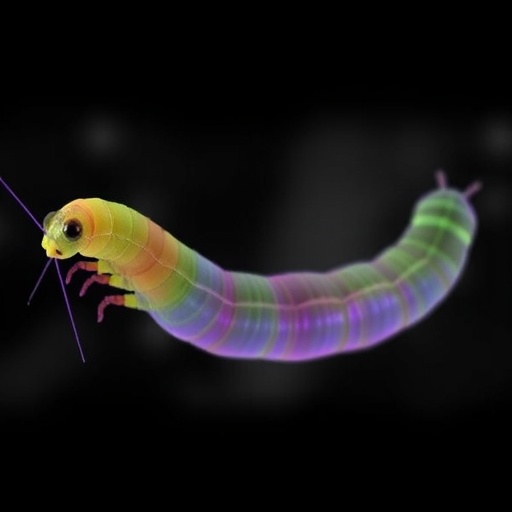In the intricate world of molecular biology, the response of an organism to pathogenic threats encapsulates the resilience and adaptability of life. Recent groundbreaking research conducted by Rajopadhye and colleagues has shed light on a critical player in the immune response of Caenorhabditis elegans, a widely studied model organism in biological research. The chromatin remodeler known as LET-418, also referred to by its alternative designation, Mi-2, has emerged as a crucial regulator in maintaining the integrity of the intestinal immune response against intracellular pathogens. The findings presented in this study not only enhance our understanding of host-pathogen interactions but also illuminate the roles of chromatin remodeling in immune regulation.
In the complex cellular environment of C. elegans, the intestinal epithelium serves as the first line of defense against myriad pathogens. The study reveals that LET-418 plays a fundamental role in modulating the chromatin landscape, which in turn affects the expression of immune response genes. This regulation is critical since the ability to swiftly and effectively respond to infection can determine the survival of the organism. The research highlights a variety of molecular mechanisms that are employed by LET-418 to orchestrate a robust immune response.
The regulatory processes initiated by LET-418 impact chromatin structure, thereby influencing gene expression during pathogen invasion. This chromatin remodeling affects nucleosome positioning and histone modification, leading to the activation of specific immune pathway genes. The study meticulously describes how LET-418 can alter chromatin states in response to pathogen-associated signals, ultimately fine-tuning the immune reaction. Such an interaction between chromatin remodeling and immune signaling emphasizes the sophisticated nature of cellular responses at a transcriptional level.
As pathogens penetrate the intestinal barrier, signaling pathways are activated, and the importance of LET-418 becomes evident. The researchers have uncovered that LET-418 facilitates the recruitment of transcriptional co-factors and chromatin modifiers that aid in establishing a transcriptionally permissive environment for immune gene expression. This process is particularly vital, as the timely expression of immune-related genes is essential for combating infections effectively.
Moreover, the analysis performed in the study reveals that when LET-418 function is compromised, C. elegans exhibits heightened susceptibility to infections, providing evidence of the chromatin remodeler’s crucial role in immune defense. The phenotype observed in such compromised organisms illustrates the potential for chromatin remodelers like LET-418 to be explored as therapeutic targets in the context of innate immunity.
The implications of these findings extend beyond C. elegans. Understanding how LET-418 functions within the context of the intestinal immune response could provide new insights into similar mechanisms present in higher animals, including humans. Chromatin remodeling factors have been implicated in various diseases, including cancer and autoimmune disorders, hinting at a shared evolutionary conserved role of chromatin dynamics in immune response modulation.
In addition to its role in responding to infections, the involvement of LET-418 in broader aspects of gene regulation can not be overlooked. Chromatin remodelers like LET-418 are critical in determining the cellular identity and signaling responses of organisms. In this research, the authors also posit that the knowledge gained could help in unraveling the complex network of interactions between chromatin architecture and gene regulation within various cell types.
The potential applications of this research range from understanding the fundamental biology of pathogen resistance to the development of innovative strategies aimed at enhancing immune responses in humans. With advancements in genetic manipulation techniques, such as CRISPR-Cas9, targeting chromatin remodelers like LET-418 may one day assist in improving immune function, possibly paving the way for novel therapeutic approaches to infectious diseases.
In conclusion, the work conducted by Rajopadhye et al. marks a significant step forward in comprehending how chromatin remodeling shapes immune responses at a cellular level. By elucidating the role of the LET-418/Mi-2 complex in C. elegans, the study not only contributes to our knowledge of immunology but also underscores the intricate relationship between chromatin dynamics and cellular defense mechanisms. Continued exploration in this field holds promise for enhanced understanding of immune regulation and potential avenues for therapeutic development.
This intriguing study further cements the significance of utilizing model organisms such as C. elegans in unraveling complex biological processes that have profound implications for human health. It is imperative that future research continues to build upon these findings, exploring the nuanced interactions between chromatin remodelers and the immune system. As we deepen our understanding, we move one step closer to harnessing the principles of nature to design innovative solutions to combat infectious diseases and bolster immunity.
Subject of Research: Chromatin remodeling and immune response in C. elegans.
Article Title: The chromatin remodeler LET-418/Mi-2 regulates the intracellular pathogen response in the intestine of C. elegans.
Article References:
Rajopadhye, S., Lažetić, V., Rodriguez-Crespo, D. et al. The chromatin remodeler LET-418/Mi-2 regulates the intracellular pathogen response in the C. elegans intestine. BMC Genomics 26, 938 (2025). https://doi.org/10.1186/s12864-025-12153-0
Image Credits: AI Generated
DOI:
Keywords: Chromatin remodeling, LET-418, Mi-2, C. elegans, immune response, intracellular pathogens, gene regulation.
Tags: C. elegans immune responsechromatin remodeling in immunityepigenetic regulation of immune genesgene expression modulation in C. eleganshost-pathogen interactionsimmune resilience in model organismsintestinal epithelium defense mechanismsintestinal pathogen defenseintracellular pathogen responseLET-418 chromatin remodelermolecular biology of infectionRajopadhye research findings





